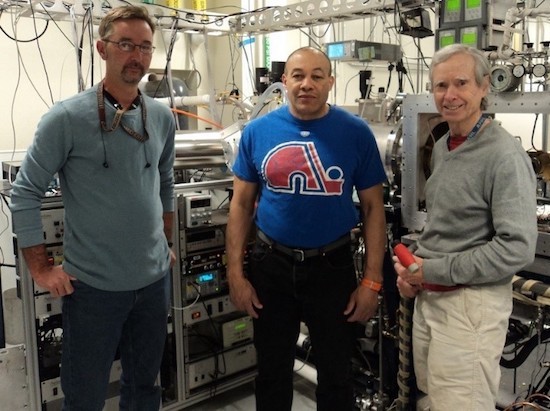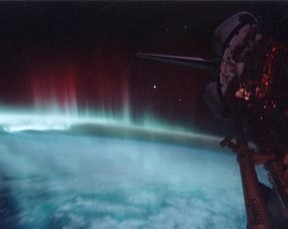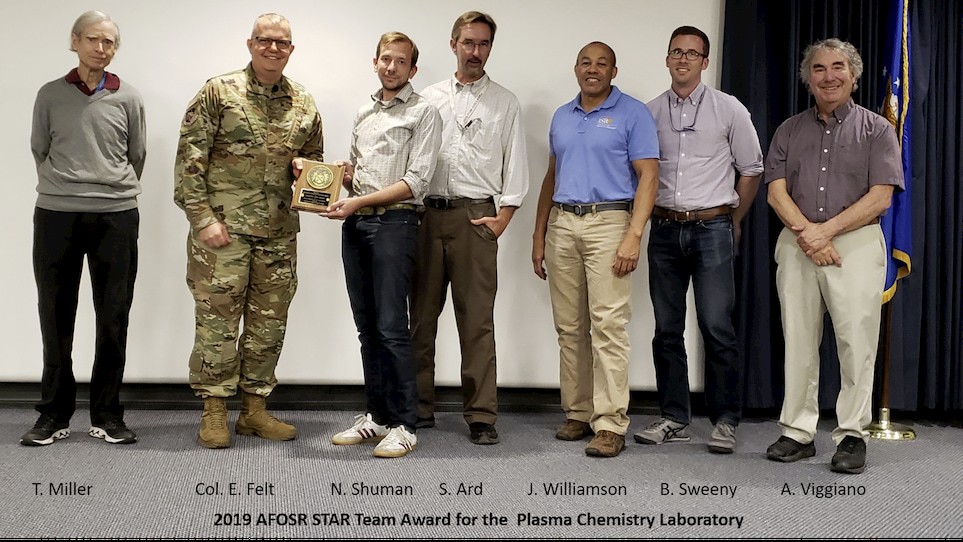Space and Plasma Chemistry at ISR
ISR researchers work closely with the Air Force Research Laboratory supporting the Plasma Chemistry Laboratory and the Space Chemistry Laboratory located at Kirtland AFB in Albuquerque, New Mexico. These laboratories conduct investigations into chemistry in the Earth's ionosphere and advance our understanding of how chemical reactions involving charged species impact atmospheric plasmas.

Physicists Shaun G. Ard (left) and Thomas M. Miller (right), and mechanical engineer John S. Williamson (center).
Plasma Chemistry Laboratory
The Plasma Chemistry Laboratory at the Air Force Research Laboratory is supported by Boston College Institute for Scientific Research researchers.
The laboratory contains four fast-flow chemical reactor apparatuses for studying electron and ion reaction kinetics at a range of thermal energies. The goal is to advance the understanding of fundamental chemical interactions involving charged species. These interactions greatly influence atmospheric plasmas, such as the ionosphere, which impact RF propagation and hence communications, as well as bond-activations employed in numerous catalytic processes such as satellite propulsion and production of energy dense rocket fuels.
The laboratory features two selected-ion flow-tube (SIFT) apparatuses capable of studying ion-molecule reactions in detail from 100-600 K. The temperature dependence of reaction kinetics in this regime are often sensitive to subtle mechanisms difficult to discern by other experimental methods. Recent work integrating new ion sources has greatly enhanced the number of systems available for study in this manner. Study of metal ion kinetics have offered insights into many catalytic processes, especially those involving fuel production, by trying to dissemble the role of spin conservation or relaxation in the course of a reaction. Addition of a Laser Vaporization (LAVA) cluster ions source has allowed for the study of systems in the “cluster” size regime, a few to dozens of atoms, which often display properties significantly different from their bulk or atomic counterparts.
The laboratory also includes two flowing-afterglow Langmuir-probe (FALP) apparatuses, operating from 100-1800 K. These apparatuses enable measurement of reaction kinetics for electron-molecule, electron-ion, and ion-ion processes taking place in plasmas over an extended thermal range. New plasma processes have been discovered in this work, e.g., electron-catalyzed ion-ion mutual neutralization. The extended temperature range is paramount in establishing a predictive understanding of the role these processes play under conditions not currently available in a laboratory setting.
In addition, the laboratory benefits significantly from collaboration with university researchers in the U.S. and Europe.
Point of contact for this research is Brendan Sweeny.
The team recently received the 2019-2021 AFOSR STAR Award as part of the Plasma Chemistry Lab at AFRL in a ceremony at Kirtland AFB, NM, Sep. 24, 2019. The award recognizes the team's “Excellence in Basic Research in Plasma Chemistry for Air Force Systems”
Pictured at the award ceremony, from left to right: Thomas M. Miller (BC/ISR), Col. Eric J. Felt (Director of the Space Vehicles Directorate of AFRL), Nicholas S. Shuman (AFRL), Shaun G. Ard (formerly BC/ISR; now AFRL), John S. Williamson (BC/ISR), Brendan C. Sweeny (BC/ISR; formerly NRC postdoc), and Albert A. Viggiano (AFRL). Not present: David M. McDonald (NRC postdoc).

Space Chemistry Laboratory (AFRL)
The Boston College Institute for Scientific Research participates in the Space Chemistry Laboratory at the Air Force Research Laboratory's Space Weather Center of Excellence. We provide scientific expertise and academic resources for basic and applied research in the outer reaches of Earth's atmosphere.
Our work primarily involves using ion beam and mass spectrometry methods to do laboratory-based investigations of the chemistry of ions in Earth’s ionosphere, with particular interest in the interaction of spacecraft with this environment.
Typical experiments involve a radiofrequency octopole guided-ion beam tandem mass spectrometer, in which absolute cross sections can be obtained for ion – molecule reactions as a function of collision energy, in the hyperthermal energy range relevant to low Earth orbit, and in which product recoil energies can be determined using time-of-flight methods.
Our studies of ion – molecule reactions also contribute to the fundamental knowledge base in this area. Among the highlights of our work are the two U.S. patents we have obtained:
#5,767,513/High Temperature Octopole Ion Guide with Coaxially Heated Rods, R.A. Dressler & D.J. Levandier;
#6,609,363/Iodine Electric Propulsion Thrusters, R.A. Dressler, D.J. Levandier & Y.-H. Chiu.
Point of Contact for this project is Ryan Booth.


